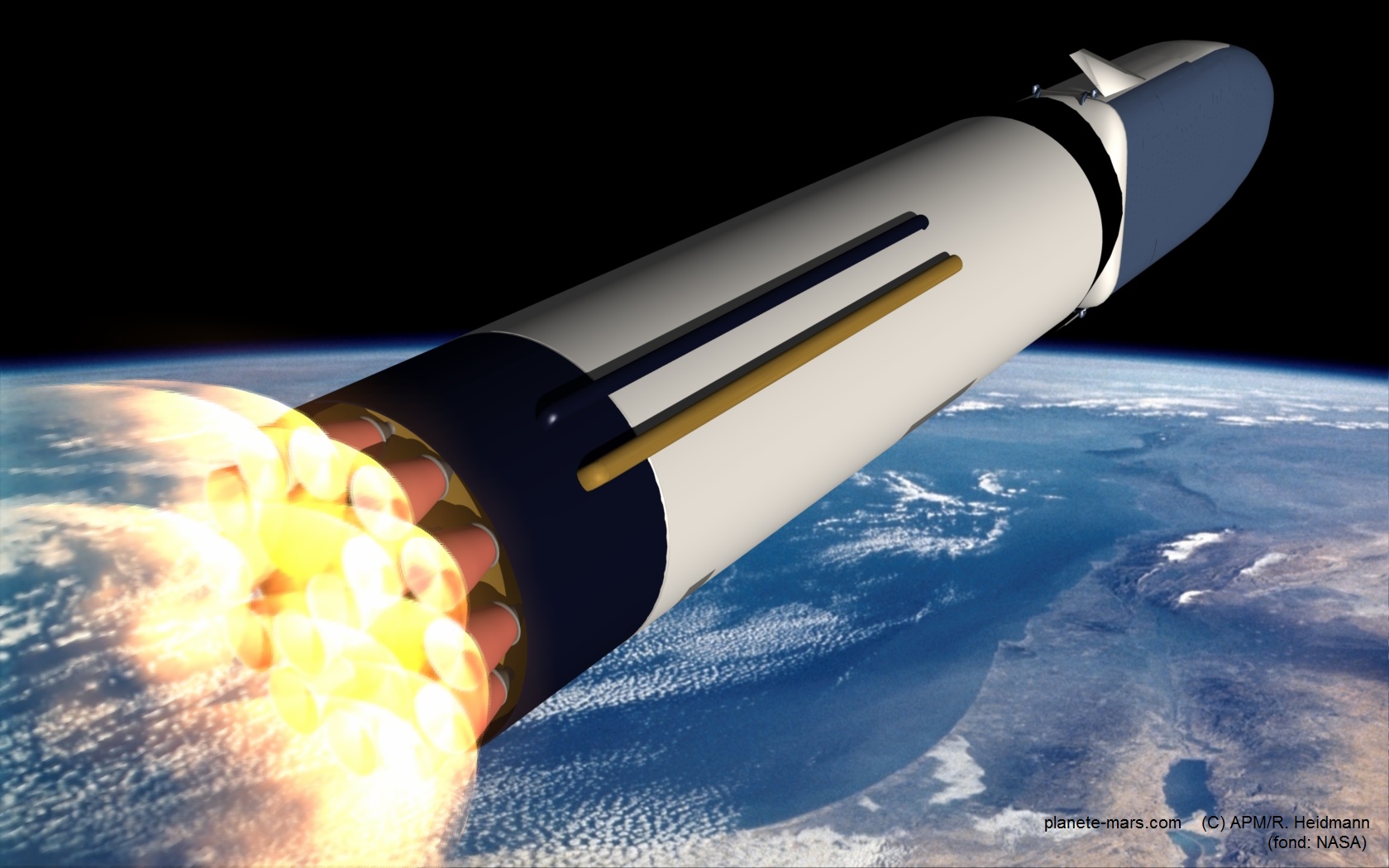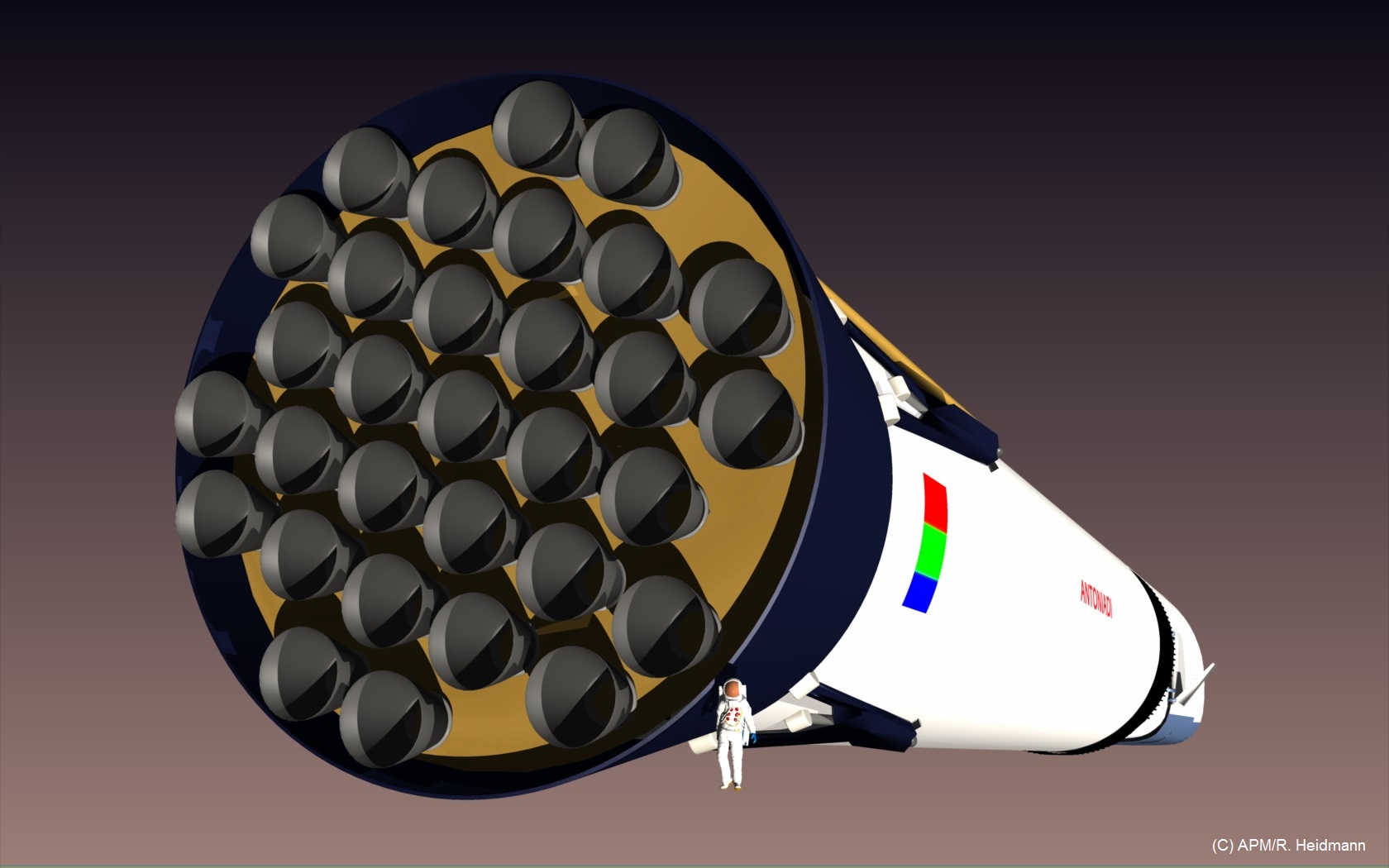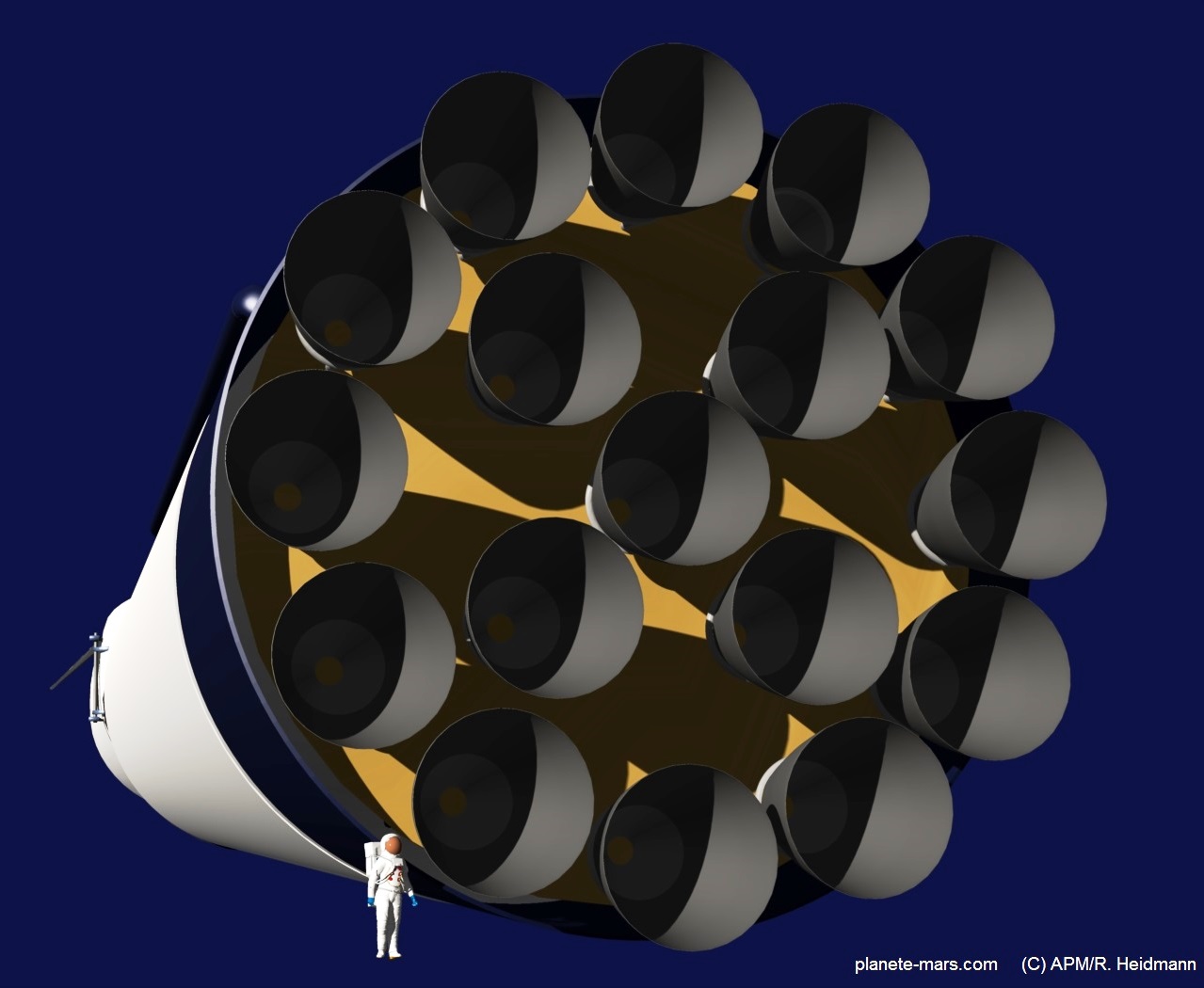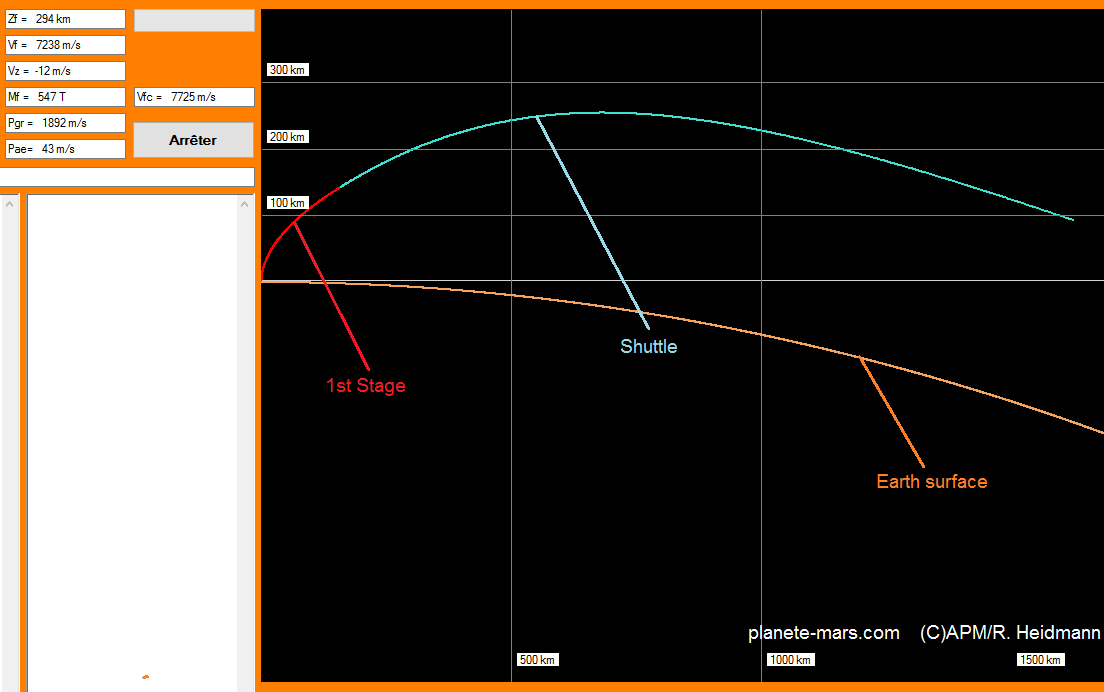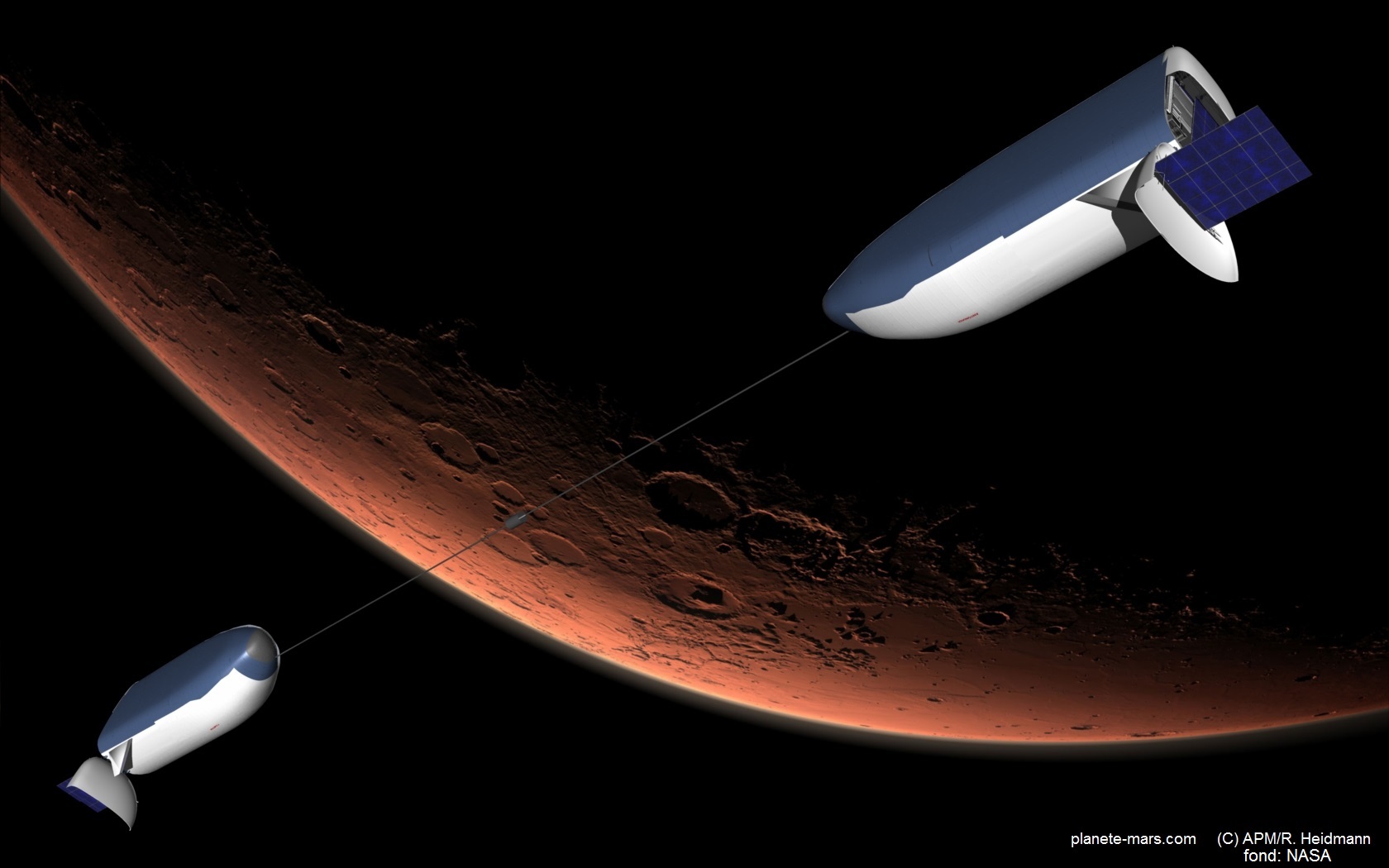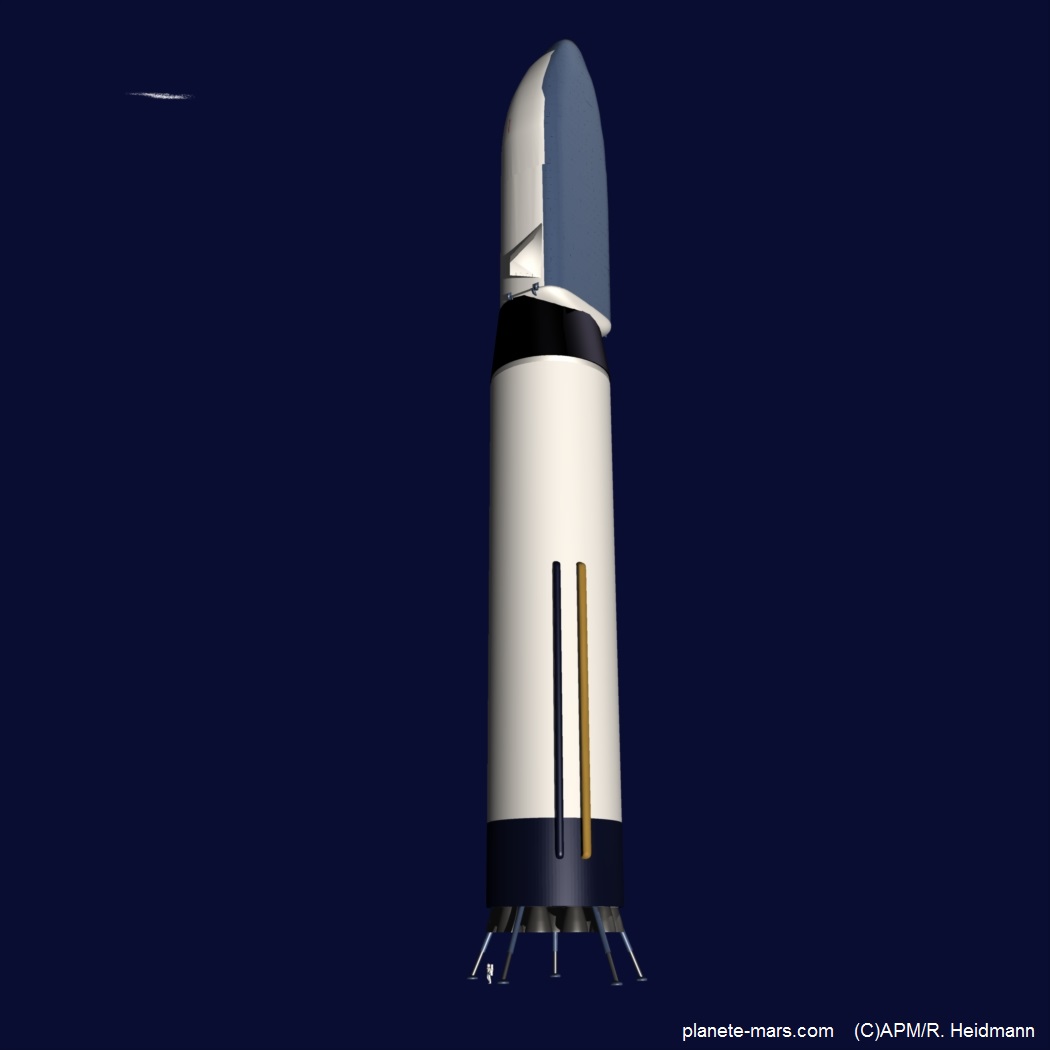Richard Heidmann
translation: Etienne Martinache
In our analysis issued at the end of 2015 (see also its summary in English) we tried to make out what the SpaceX project called Mars Colonization Transport (MCT) would look like. Let us bear in mind that Elon Musk should disclose the details of this project on 27th September 2016 at the occasion of the next International Congress of Astronautics. This guesswork exercise took into account then the sparse amount of clues gleaned among the various statements made by the famous space entrepreneur, some of which seemed to contradict previous information (for instance: dropping the multi-body launcher option, Falcon Heavy type) or, on the contrary, seemed to confirm basic options such as refueling on earth parking orbit by a second launcher, total re-use and descent on Mars of the whole interplanetary shuttle (« landing the whole thing »). Since then, other clues from various sources showed up on the internet discussion groups of space enthusiasts. Let us have a look at their possible meaning.
A 15 m diameter launcher
In order to meet the required performance (landing a 100T payload on Mars), choosing a single body and re-usable launcher led us to increase the diameter of the propulsion bay to 15m, even if it looked like keeping the diameter of the stage proper to 12.5m was sufficient (for the record, the diameter of first two stages of the Saturn 5 lunar rocket was 10m). This configuration made it possible to accommodate a maximum quantity of 31 motors of 300T of thrust each and reach a total weight before liftoff (Gross Lift Off Weight or GLOW) of 7750T. Unfortunately, the flared shape of the bottom part of the first stage of the rocket, while favorable to its stability during the ascent phase of the flight, is very unfavorable during the re-entry phase (reverse flight), all the more so as the means to stabilize the trajectory are then much less efficient during this phase. Since it is not reasonable to reduce the GLOW and consequently the liftoff thrust, the solution consists in bringing the diameter of the whole stage up to 15 m. Now, one of the rumors spread across the « MCT-geeks » discussion groups deals precisely with that option; SpaceX is said to have sent requirements to tool suppliers for this same diameter.
A Gross Lift Off Weight (GLOW) of almost 10,000T
At that time, the motor type mentioned was a 250T thrust Raptor (optimal size per mass according to SpaceX). While not increasing too much the quantity of motors (considering what is usually accepted by Falcon Heavy specialists), we had deduced that the motor thrust should be brought up to 300T, which makes it still possible to accommodate them within a 15m bay diameter. The problem is that even with such a high power level, the required performance is still not met (unless we consider that our assumptions regarding the shuttle structure weight are too pessimistic); indeed this configuration leads to a possible payload on Mars of 90T (while the desired workload is 100T), moreover the calculation was made taking into account the most favorable conditions: Mars at the perihelion and long duration transfer orbit (Hohmann transfer orbit). Now, another rumor going around is that SpaceX is considering a 700T thrust Raptor! This amount of unit thrust would make it possible to increase significantly the liftoff capacity and overpass the thrust requirement, which can then be reached with 13 such motors only, which are easy to accommodate within the bay. Considering the performance reduction, we may speculate that, once the decision has been made to go for a 15m diameter bay, SpaceX will look forward to accommodating the highest number of motors possible in the propulsion bay. Here are compared preliminary designs showing what the first stage would look like for two versions, 1) initial version (bay diameter: 15m, stage diameter: 12.5m, thrust: 31x300T = 9300T, GLOW: 7750T) and 2) a more powerful version (bay and stage diameter: 15m, thrust: 17x700T = 11900T, GLOW: 9917T).
Bay diameter: 15 m, top thrust: 31x300T, bottom thrust: 17x700T (GLOW increased by 2166 T).
The present arrangement makes it possible to ensure a tangential deflection of the four motors located in the median row (those which are set up as a square in the middle) in order to make them steerable. Rolling efficiency would have been better by steering the outlying motors instead (those which are set up as a circle on the outside row), but they are packed too tightly close to each other to allow a significant deflection range.
Ambitious performance objectives
The configuration of the launcher of our study did not meet required performances. Now, during a recent interview, when discussing the hardships endured by the passengers because of the long transfer travel time (typically 6 months or more), Elon Musk made these requirements even more stringent, saying that a 3 months duration would be acceptable.
From a parking orbit located in LEO at 300km altitude (note: other parking orbits are considered too: elliptical orbit, lunar Lagrange point …), necessary ΔVs (velocity changes) are (not accounting for gravity losses):
when Mars is close to its perihelion:
4.48 km/s for a 91 days trip (for instance 26th June 2003 till 25th Sep 2003)
when Mars is close to its aphelion:
6.72 km/s for a 92 days trip, completely unrealistic ΔV
5.02 km/s for a 122 days trip (4 months), still acceptable duration.
Performances of the new configuration
Does the additional capacity brought by this thrust increase, applicable not only to the interplanetary shuttle but to the refueling vessel as well, make it possible to meet, or get close to, these performances?
Calculated trajectory (approximate optimization, non-algorithmic). Pgr: gravity losses; Pae: aerodynamic losses.
By spreading almost optimally the additional 2166T of GLOW among the propellant of the first stage (and to the 4% increased weight of the propellant tanks) and the propellant of the shuttle (which acts as a second stage for the injection into LEO), the trajectory calculations applied to the operational flight lead to the following weights:
| First stage propellant (useful + return reserve) | 7810 T |
| First stage propellant (useful) | 7100 T |
| Shuttle propellant | 1300 T |
| Load injected into LEO (300 km altitude) | 547 T |
| including leftover shuttle propellant | 295 T |
As for the LEO refueling flight, assuming that the weight of the automatic shuttle, which will feature neither habitat nor emergency capsule, will be brought from 109T down to 89T, we get:
- leftover refueling vessel propellant after injection into LEO: 458 T
Once the refueling phase is over, assuming a percentage of 5% losses during the propellant transfer operation (applied to the refueling vessel load), the interplanetary shuttle will still be provided with 730T propellant.
Let us assume an Isp (specific impulse) of 380 s [1] corresponding to motors designed for operation in space, fitted with spread out bell shaped nozzles.
The transferred mass, as calculated in the study, was 244T, corresponding to a 90T payload on the Martian surface and a long trajectory flight (8 to 9 months). But let us come back to the original 100T payload, meaning the transfer mass becomes 254T.
Let us point out that the trip time reduction makes it possible to decrease the stock of food and water which will not be recycled, around 2kg/day/passenger). However these should not be included in the payload, even if the final residues (organic waste, grey water) will be obviously welcome and recycled by the Martian colonists.
Taking these data into account we get the maximum possible DV:
DV = g0 Isp Ln (1 + Propellant weight / Final weight)
DV = 9.81 x 380 x Ln (1 + 730 / 254) = 5.05km/s
The final calculated configuration will therefore meet the requirements of a 3 months duration trip (4 months in the most unfavorable case, with Mars at aphelion), the radiations dos will be divided by 2, compared to a typical travel duration (6 months)!
And what about weightlessness?
Six months trips in weightlessness are common practice in the ISS and do not cause long term health damage, whether physical or psychological. Nevertheless, all the more so in case of mass transportation of “ordinary” passengers, it would be preferable to generate artificial gravity on-board (preferably Martian gravity), so that visitors may disembark in top shape after landing. There is a simple way to do that, it has already been described in the Mars Direct project.
Colonization models, such as the one we are now working on (1000 residents settlement built over 20 years) require several MCT flights per synodical window (6 in the present case). By connecting the shuttles to each other (two by two) during the transfer flight, it is possible to generate Martian gravity (0.38 g) by rotating the whole set (for instance at 2 revs/minute, rotation speed tolerated by human body), if the distance between the two mass centres is 170 m.
Therefore the two main environmental risk factors affecting the travelers’ health remain under control!
One couple of shuttles of the transfer flotilla, still operating under artificial gravity, is nearing its destination. The mass centres of the two vessels are 170m distant and the whole set rotates at 2 revs/minute around an axis selected so as to ensure that the solar panels remain lit perpendicularly.
Size evolution
By increasing the propellant mass and increasing the diameter from 12.5 to 15m, the total height of the first stage decreases from 71 to 64m, which makes it a bit stocky and may shed another light on the rumor that the Falcon type deployable feet, necessary considering the considerable slenderness of this rocket, could be replaced by retractable feet, going in and out longitudinally from the bottom of the stage.
In the present project, the diameter of the shuttle itself could also be increased up to 15m, which would make it possible to accommodate the propellant tanks, the capacity of which increased from 1100T to around 1300T. The arrangement of the motors would thus be also much easier to manage.
The total height of our tentative MCT (excluding the feet) is around 110 m. Same height as the Saturn 5 – Apollo lunar rocket, but the MCT diameter is 50% bigger and its gross lift off weight 3.4 times larger.
Picture showing the size of a 15m diameter and almost 10000T liftoff weight MCT, propelled by seventeen 700T motors. Will the actual MCT look like that or will SpaceX surprise us again by its innovations?
Other rumors
(beware: information not crosschecked, to be considered with reservations).
- Cargo vessels will be flown before the first human mission, so that pioneers may have at their disposal everything necessary for their survival and to start setting up a colony. No, the Falcon Heavy/Red Dragon flights, the first of which should take place as early as 2018, will not be devoted in priority to scientific payloads, but to these preparatory cargo missions instead.
- Among the hardware flown during the preliminary missions, it will be necessary to include an electronuclear generator. Its mass could reach 20T, its output power 5 to 10MWe and it should be able to bury itself into the ground!
- Some people are said to have seen at SpaceX a whole series of prototype spacesuits, which have not been disclosed yet … But nobody knows whether the innovation will apply only to their design (let us forget bulky suits such as those of “20,000 leagues under the sea”) or also to their technology.
Financing capacity
Regardless of future participation of agencies (by driving effect) most of the financing of the MCT development and landing on the Martian surface of the hardware necessary to set up a first permanent human settlement will likely depend on Elon Musk’s industrial success. Elon Musk has many times issued statements which leave no doubt on his « Martian » strategy:
- refusing, despite market pressure, to list SpaceX on the stock exchange « as long as MCT is not operational », in order not to hinder its march towards the Mars [2] objective;
- financing developments by the profits of commercial markets;
- using developments made on existing contracts (for instance Dragon 2) in order to finance necessary technologies and hardware;
- industrial development (Tesla Motors, Solar City, but also Internet satellites constellation, HyperLoop?) These developments will be indispensable because « a huge amount of money will be required to make colonization possible»;
- having raised a capital of more than 45 billion USD (over a dozen years), around 20% of which he owns, Elon Musk thinks that, because of the existing synergy between solar panels – batteries – electrical vehicles that he is building up, this empire may one day be worth 1000 billion USD! This ambitious and optimistic forecast is based on his analysis that solar energy industry has addressed only 1% of the potential world market so far; we can even wonder whether by raising “only” a few hundred billion USD capital, resulting profits alone may make it possible to finance the Martian dream of the multi-entrepreneur…
A thrilling business initiative which carries the hallmark of risk
Spectacular achievements may comfort various stakeholders (shareholders, banks, customers) of this vast industrial enterprise oriented towards reaching the top target: Mars. But they do not guarantee that the next challenges will actually be met… The action is being played off the beaten tracks, Space X is confronted to well established and fierce competition, and must cope with an unusually high level of risks. Technical risks, of course, consequential to the frantic pace of innovation at SpaceX and Tesla, but, most of all, financial risks, which make the business world nervous and raise serious concerns in their midst. All the more so since, when technical challenges are met, very often the company’s contractual completion times are delayed. Numerous bold decisions were taken over the last few years, essentially to ensure the development of Tesla:
- Investing 5 billion USD (with Panasonic) in the batteries manufacturing « Gigafactory » (opening ceremony end of July);
- Announcing a production target of 500,000 cars in 2020, compared to 50,000 in 2015 (but the 2016 target was revised downward middle of this year…);
- Further to the historical success of the pre-orders of the Tesla Model 3, deciding to anticipate this target to 2018, thus causing disbelief among shareholders and an unpleasant dilution of the capital due to issuing 1.4 billion USD additional shares in order to fund the increased production rate;
- Recent bid to purchase Solar City (around 20% of which is already owned by Musk) for an amount of 2.5 billion USD, this transaction is deemed as a further dilution of the capital by Tesla shareholders;
- Tesla main financial indicators remain in the red (persistent losses, high level of debt, and high level of capital consumption…), justified in the managers’ opinion by the future size of the market;
- Creating within SpaceX a satellites division, announcing a new objective: launching the company’s own constellation of orbiting satellites dedicated to universal spread of Internet; this initiative was apparently later abandoned, curiously SpaceX still publishes numerous job ads for communication satellite specialists… Competitors are very powerful!
Conclusion
Elon Musk’s Martian ambition should not be considered as a Utopian dream. On one hand because the numerous and smashing successes of the entrepreneur have set up and strengthened his credibility. On the other hand, as we see his innovations slowly materialize, the strategy of his approach of the Martian objective definitely takes shape. It grows more and more distinct and convincing, on the technical side of course, but on the economical and ethical sides as well, which is fundamental.
Indeed, why should we establish a settlement on another planet if this does not lead to a useful and sustainable achievement in the long run, that is able to provide advantages and services, proving its usefulness through a viable market and able to ensure its own financing of its needs for imported goods? This is another way to ask the same old question again: going to Mars, to do what? On this matter, Elon Musk was very clear: for him, a settlement must be a business, because it can neither afford to be funded in the long run from the outside, nor build a future of its own if it does not find its autonomy, self-reliance and long term purpose.
Many ideas, so far not quite convincing, were suggested in the past as far as marketable goods and services that a settlement could offer. The development of a cost effective and massive interplanetary transportation system, as envisioned by SpaceX, sets up a completely new deal. This is the reason why Association Planète Mars (APM) is studying a possible economical model of such a settlement. Awaiting the big announcement on 27th September 2016!
[1] This value of Isp may look a little optimistic. Now, a LOX/Methane Russian motor reached an Isp value of 386s (during ground tests).
[2] Listing Google at 900 million USD made it possible to estimate SpaceX’s value: 12 billion USD.


